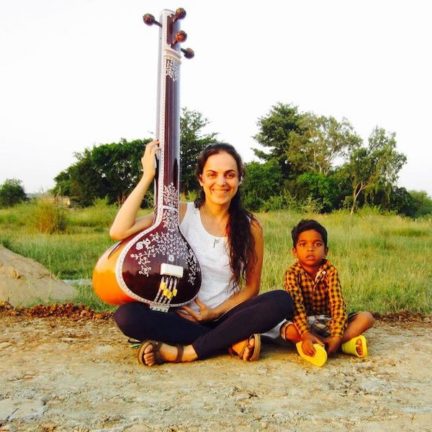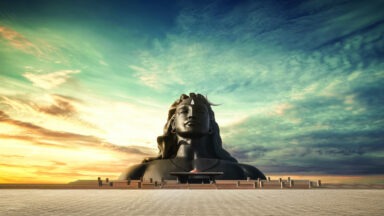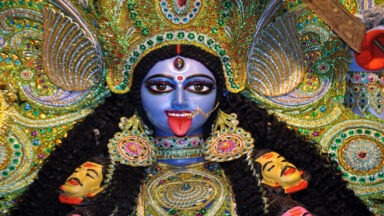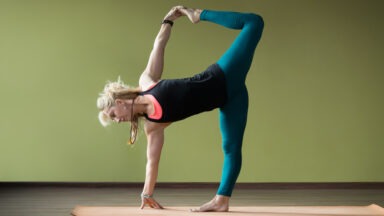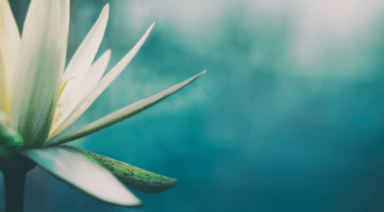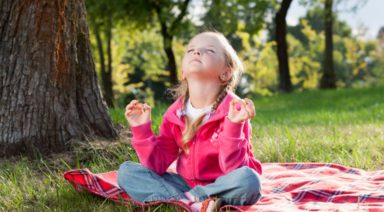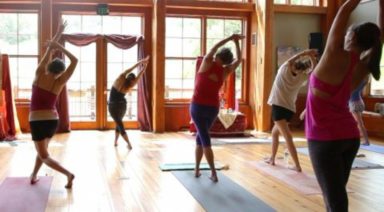Nada Yoga: The Yoga of Sound

The first time I went to India, little did I know that my life was going to completely change. I know, many people come back from India saying they transformed. It happened to me, too.
At that time, I was a singing student at the university in Montreal and was feeling blocked. My voice was weak and so was my morale. I heard that in India, before a concert, a singer would sometimes sing ‘om’ for almost one hour, reconnecting to their soul, before starting the performance. I became very intrigued. “Maybe I could also find a way to reconnect to my voice?” I thought to myself. I bought my airplane ticket and suspended my university studies for one semester.
I didn’t know where to go; India is huge! However, a whole series of coincidences brought me to my teachers and I started my journey. In my first class, one of them asked me to sing an “A” sound, which I did. He listened. After a few moments of silence, he said “You are not connected to your voice.” I smiled, as I thought to myself: “That is exactly why I came. I must be in the right place.”
That was the beginning of a fascinating adventure and my initiation into the Nada yoga tradition. I had no idea at the time that I would be touched in the depths of my soul, healed in places I didn’t even know needed healing. After a few months of studying with them, I came back home, and my voice was transformed and my career shifted unexpectedly. Above all, I came back humbled. Now, I spend half the year, every year since, studying in that country, deepening in this path and sharing this knowledge with people in the West.
What is Nada Yoga ?
Nada, from the Sanskrit “नाद”, means “sound”. Nada Yoga is the yoga of sound.
There are different ways in which you can explore sound on your yoga journey. While some Nada Yoga practices have been well documented and are mentioned in the sacred texts, other practices have only been passed from generation to generation, mostly as oral traditions.
Russill Paul is a contemporary Nada yogi who has written extensively on the subject, and who suggests a classification of four different branches of Nada Yoga. While this classification is not official, it helps explain the different aspects of this form of yoga.
Shabd and Shakti
The first two branches are called, according to Paul, Shabd Yoga and Shakti Yoga. Both focus on mantras and their mystical properties, but their origins and ways of practicing differ.
Bhakti
The third branch is called Bhakti Yoga. Bhakti means devotion. Bhakti Yoga is all about chanting devotional songs to connect to a space of grace.
Nada
The fourth branch of Nada Yoga, according to Russill Paul, is also called Nada Yoga. It uses pure sounds as a means of meditation. There are no mantras involved.
The last branch – the one in which I am specializing – overlaps with classical Indian music. Classical Indian music is a very complex, refined tradition. It is a deeply mystical art form, and although one can study this music without exploring Nada Yoga, one finds that the Nada Yoga journey lies at the very core of this art. So, a musician can develop a Nada Yoga sadhana (spiritual practice) along with their musical development.
Of course, it is not necessary to be a professional musician to benefit from these practices. I have taught Nada Yoga classes and workshops to people from varied backgrounds, and found we all can benefit greatly from it. Ultimately, this is not just an exotic form of yoga.
Nada yoga is about you and how you relate to yourself, how you inhabit your body, how you align your mind, how you express your soul.
Let me give you a taste of it. Since I’m specializing in the fourth branch mentioned above, and more specifically on voice, I will share with you a vocal exercise from that branch.
Aakar: A Singing Practice
Take a moment now. Sit in a comfortable position, ideally with the back straight. As you are reading this text, take a deep breath and scan your body: is there any tension anywhere? See if you can become a bit more aligned, a bit more relaxed in your posture. Take your time.
When you feel ready, take another deep breath, and let a simple /a:/ sound come, as in the word “spa”.
Listen to yourself as you sing this tone. Pay as much attention to the act of emitting a sound as to the act of listening to it.
Now, check in with yourself: are you afraid of expressing this sound? If yes, then see how it feels to take your space a bit more. Don’t force yourself to open up all at once. Just gently explore the possibility of taking more space around you with your voice.
Are you feeling tense, anxious? Can you hear that in your voice as well? Just observe and listen. Is your voice shaking? Let it shake. Do you feel frustrated that it is shaking? Let frustration be. Does it feel stuck? Let it be stuck. Discover the relief of allowing yourself to be, just as you are, right now.
So often in our lives we have to compromise, adjust, refrain, etc. But here you have an opportunity to create an inner temple for yourself. Give space to for your voice to be exactly as it is. Receive and give space to whatever comes up. But in your mind, remain focused, aware and equanimous. As you keep this neutral witnessing quality, you will notice that your voice will gradually settle down, open up and naturally realign itself.
Observe the Body
Continue breathing deeply, and calmly singing your “A” on the exhalations. Then, observe the body.
Keep watching your posture, so that it is aligned and keep listening to yourself. See if you can let your body become more open and relaxed, but not so relaxed that your sound becomes feeble. Find balance between tonus and relaxation. Look for that middle point. Now look at your shoulders, your neck. Necks tend to tense, especially when singing. See if you can relax that region.
Scan your chest, your face, your jaw, your eyes; bring release to these parts, too. Observe your belly and your hip area: these are areas where we often hold tension. Sing your ‘A’s as you focus respectively on each area, and bring some deeper tonus and relaxation to them. In more advanced states of practice, we can actually bring the sound vibrations to different parts of the body, but for now, let’s just focus on them, letting your voice open up as your body realigns itself.
As you explore this practice you will notice your mind wandering again and again. Bring it back, again and again. My teacher said something one time that I never forgot: “Mental power has to be developed gradually. It is not a matter of one to two hours, or one to two weeks… or even one to two years. Mental power has to be developed over a long time. What is mental power? The power to focus.”
So use this exercise as an opportunity to develop that. You will find that as you develop it, you start to reach deeper levels of perception, insight and peacefulness. It will also allow you to access deeper levels of the practice and open your voice even further.
As your mind settles you begin shining presence on your vocal expression, and it starts to transform. Imagine a channel that has been clogged for a long time. Once you pass some water through it, gently, over and over, slowly it starts to unclog. Likewise, your voice, totally welcomed as it is, united with your conscious presence and aligned posture and breath, becomes like water to your system. Slowly you are unblocking your inner pipe; you are realigning your system. With this exercise, you are peeling away, gradually, all these layers of subconscious blockages that we all carry around.
Much more could be said about Aakar practice, but this is a good introduction. If you are new to singing, practice up to 30 minutes at a time, as your vocal cords might get tired if you practice longer. Drinking water throughout your practice is also recommended to keep your throat hydrated. Now remember, breath work, body alignment and mental focus are the key aspects here. Without these the “yoga” aspect of this practice is gone.
Aakar can be very simple at first sight, but you might discover tremendous depth in it. It is one of the main exercises we do in the tradition I am studying. For in-depth work, it is recommended that you have an assisted practice, so that you can understand all the different ways in which you, personally (and often unconsciously), block your voice. But with this simple written explanation you can already benefit a lot.
The Power of Your Voice
Voice is such a great tool to guide us in our life quest, because it is a very loyal mirror of our inner reality. Our voices change every day, depending on how we feel, and how our bodies and minds are. In ancient traditional medicine systems, such as Traditional Chinese Medicine (TCM) or Ayurveda, voice has been used as a tool of diagnosis. Just by listening to the voice the doctor can get information about the patient’s overall health condition.
We also can make the best use of this amazing tool, not only as a means of diagnosis like in these medicinal traditions, but as a guide to liberation. We can let our voices guide us into deeper alignment, emotional release, reconnection to our essence, mental clarity and inner peace.
It has been scientifically proven that the whole universe is made of vibrations. The ancient Indian scriptures actually affirm that the universe was created by sound. As you experiment with different Nada Yoga practices, maybe you will also find that sound is indeed a powerful doorway into the Great Mystery.
I wish you all happy explorations in your yoga journey.
10 Ways Yoga Practice Can Lessen Your Holiday Stress

There is no better time to take your yoga practice “off the mat and into your life” than over the holidays! Whether you are a new student of yoga asana (movement) or a seasoned yogi, here’s a handy guide for using all the tools at your disposal–including breath, movement, and mindfulness–to limit stress and maximize happiness in the coming months:
1. Stay healthy.
Chronic health issues often flare up over the holidays, so don’t forget to use your yoga practice as preventive medicine. Keep persistent symptoms at bay with a daily dose of yoga. Drain your lymphatic system and increase blood circulation through postures and movement.
Try combating infections and colds by opening up your chest with a gentle fish, bridge, or bow pose. Don’t skimp on your yoga just because you are busy! Everyone has time for a quick round of sun salutations in the morning, a few standing forward bends at lunch, or some breathing techniques before bed–no mat or props needed. Remember the old saying: An ounce of prevention is worth a pound of cure. Were they talking about yoga?
2. Be worry-free
“I’m so stressed out. My mind is racing. Everything seems overwhelming. I just can’t stop thinking!” Are anxious feelings wearing down your holiday spirit? Politely excuse yourself from the party; turn off the computer – just take a break. Find a quiet, peaceful spot for some yogic mantra or meditation. You can quickly detach from worrisome thoughts by focusing on the individual sounds of the mantra or by simply following the breath – in and out.
Sometimes a longer exhalation or pausing at the end of your out-breath can calm a speedy mind. If time permits, do some asanas – child’s pose to really let go, balancing poses (like tree pose) to connect to earth and sky, or toe squat to stretch your feet and take the focus out of your mind and into your body. A restorative yoga session can be an hour well spent; your worries will literally melt into the mat and leave you feeling clear and refreshed.
3. Increase your concentration.
As if your life isn’t hectic enough, add in holidays with extended family, shopping, school recitals, the annual office party; the list goes on! All these distractions can wreak havoc on our memory, concentration, and problem-solving. In order to stay productive, incorporate asanas that increase mental focus–like warrior I, II, III, dancer’s pose, eagle pose, or shoulder stand–into your practice. Activate your tired brain with a series of breathing exercises. You can do them anywhere, anytime, seated or standing.
Really crunched for time? Take a few moments sitting in a comfortable seat (eyes closed or with an unfocused gaze), or stand in mountain pose with your hands in anjali mudra (palms together in front of your chest). The simple act of remaining still with palms pressed together can help bring you back to your center.
4. Keep your body toned and fit.
Maybe you’ve done one yoga class, maybe one thousand. No matter your strength, flexibility, muscle tone, core stabilization, balance, cardio health, enhanced athletic performance–the benefits of yoga become apparent with that very first stretch or twist. You might have a consistent practice when November rolls around. Suddenly there’s no time to cook dinner, let alone squeeze in an entire yoga series.
What to do? Do something rather than nothing! Try adding a few minutes of yoga before or after a workout, run or walk. Strike a few powerful poses before the kids get up in the morning, or discretely activate your core with tummy toning exercises while sitting on the couch. During the holiday season, concentrate on the target areas most important to you, and the rest can wait. If you need shoulders flexibility, keep up your downward dogs; if your spine is an issue, don’t skimp on back-bends, forward bends, and twists; if tricep strength is what you’re after, practice chaturangas as often as you can during your yoga flow.
5. Keep your weight stable
Everyone knows a good yoga series burns calories, builds muscle, and provides your body with a systematic, holistic workout. More importantly, yoga practice helps you make friends with your body. This is no small statement. When you know your body, you eat more consciously, recognizing the difference between a food craving and actual hunger. You make more sensible food choices, and intuitively eat less because you know when you are actually full.
Over the holidays, even our most thoughtful meal planning can be disrupted, it’s hard to say no to grandma’s pumpkin pie, or your cousin might be eyeing your dinner plate to see if you’ve eaten all his homemade mashed potatoes. Try keeping your “yogi mind” at family dinners. Stay centered, drink plenty of water, and don’t forget to breathe deeply when you feel stressed or overwhelmed. You can also practice cardio yoga styles during the holidays– power vinyasa, warm or hot flow, sculpt with weights–to get maximum aerobic benefits in the shortest amount of time.
6. Lift your mood and maintain a positive outlook.
Yoga practice is a great way to boost sagging spirits and tame your depression. Yoga raises your heart rate and gets the blood flowing throughout the body.
If you are feeling blue, try stretching your arms overhead and spreading your toes wide in a simple raised arm mountain pose. Backbend in bridge or cobra, opening your chest, rib-cage, and heart. Any inversion that gets your head lower than your heart–supported headstand, legs-up-the-wall pose, shoulder stand, or handstand–can have a positive effect on mood. If the holidays have really got you down, remember to take care of yourself.
Relax and rejuvenate in your favorite restorative pose; don’t skimp on any blankets or props needed for extra comfort. For mental stimulation, use a breathing exercise like bellow’s breath to stir your prana – it’s better than a cup of coffee! Let your yoga practice serve as a physical reminder that your mood won’t stay low forever. Change happens all by itself if you stay on your mat, breath, and follow the sequence of poses.
7. Sleep more
Work is stressful and your parents are coming for an extended holiday stay. You’re worried and anxious so it’s hard to fall asleep. You toss and turn all night, and now you’re cranky and irritated at breakfast. The sleep deprivation cycle begins and with it all the troubling symptoms; insomnia, exhaustion, overstimulated nervous system, chronic stress, sensory overload, muscle tightening, tension headaches, and more.
How can yoga help? Get in a rigorous session during the day, so your body is tired by nightfall, or try a gentle yoga series before bed. Deep exhalations allow your nervous system to relax and your breathing to slow down. Use poses that relieve physical tension such as spinal twists (seated or supine), plow, or a gentle forward fold (let your head hang). Turn out the lights, turn off the day. Climb into bed and let it all go with a final savasana.
8. Improve your vitality and energy
What happens when you follow a sequence of yoga movements choreographed to the rhythm of your breath? Your blood flow increases, more oxygen gets delivered to your cells and tissues, red blood cell and hemoglobin counts rise. You feel rejuvenated. What about when you’re tired? A series of sun salutations can warm and stimulate both the body and the mind. Chair and eagle are also energizing poses you can do anytime; hold them longer to generate more heat and internal energy.
Be sure to make an extra effort to keep your yoga practice going over the holidays; you’ll be rewarded with more vibrancy and stamina to enjoy the whole winter season. Did you overindulge in turkey, stuffing or green bean casserole at Thanksgiving dinner? You’re not alone. Intestinal symptoms like indigestion, acid reflux, bloating and constipation can sap your energy. Wind removing pose (wide leg, legs together, or one leg at a time to target different segments of your colon), twisting poses (to massage your abdomen), reclining bound angle pose (for all your abdominal organs), or some gentle cat-cow movements can offer instant relief for intestinal distress.
9. Maintain your mind-body connection
First, you cut your thumb chopping walnuts for the holiday cookies. Then you trip in your new high heels, twisting your ankle, and minutes later you spill wine on the carpet. Why are we so clumsy and accident-prone during the holiday season? Blame it on the stress- feeling overwhelmed can make you move too fast, lose your mind-body connection, and react with a fight-or-flight response to ordinary situations.
After bandaging your thumb, soaking your ankle, and cleaning the wine stain, cut the cycle of mindlessness- come back to your yoga! Try breathing exercises, balancing poses, or seated meditation. The mindfulness coupled with the physical embodiment your yoga brings can help you recover faster, protect you from further injury, improve your coordination and reaction time, and help you balance better (especially in those heels).
10. Be centered, present, and in the moment
Your commitment to yoga practice is the most precious gift you can give to yourself. Don’t hesitate to use all of your yoga tools– breath, movement, and mindfulness– to keep your holiday season stress-free. Enjoy. Appreciate. Celebrate. Mourn. Rejoice. Connect. Forgive. Extend. Radiate. When you are centered, present, and in the moment, you can give and receive, love and be loved, touch and be touched back. Happy Holidays and Happy Yoga.

